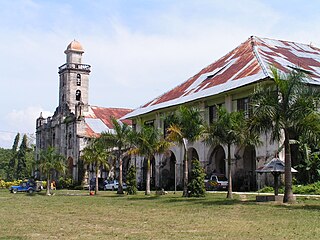
Alburquerque, officially the Municipality of Alburquerque, is a 5th class municipality in the province of Bohol, Philippines. It had a population of 11,246 people at the time of the 2020 census.

Baclayon, officially the Municipality of Baclayon, is a 4th class municipality in the province of Bohol, Philippines. According to the 2020 census, it has a population of 22,461 people.

Loboc, officially the Municipality of Loboc, is a 4th class municipality in the province of Bohol, Philippines. According to the 2020 census, it has a population of 17,418 people.

Historical markers are installed by the National Historical Commission of the Philippines (NHCP) in the Philippines and places abroad that signify important events, persons, structures, and institutions in Philippine national and local histories. The plaques themselves are permanent signs installed by the NHCP in publicly visible locations on buildings, monuments, or in special locations. Local municipalities and cities can also install markers of figures and events of local significance. Though they may have the permission of the NHCP, these markers are barred from using the seal of the Republic of the Philippines.

The Saints Peter and Paul Parish Church, commonly known as Calasiao Church is a baroque church located in Poblacion West, Calasiao, Pangasinan, Philippines. It belongs to the Vicariate of Sts. Peter and Paul under the Ecclesiastical Province of the Roman Catholic Archdiocese of Lingayen-Dagupan. The 57, 840 Catholics is under the pastoral care of Rev. Fidelis B. Layog, assisted by Rev. Isidro Palinar, Jr. and Rev. Raymund Manaois.

Maribojoc Church, also known as Santa Cruz Parish Church or Holy Cross Parish Church, is a Roman Catholic parish church in the municipality of Maribojoc, Bohol, Philippines, under the Diocese of Tagbilaran. The parish was first established by the Jesuits in 1767 or 1768 with Father Juan Soriano, SJ as its first parish priest. The Augustinian Recollects later administered the community until 1898.

The Fort of Saint Vincent Ferrer or commonly known as Punta Cruz Watchtower (Tagalog: Bantayan ng Punta Cruz) is a Spanish colonial era watchtower located at the western tip of the municipality of Maribojoc, Bohol, Philippines. Also known as Maribojoc Watchtower because of its geographical location, it is located three kilometers (1.9 mi) away from Maribojoc Church. It is known for being the "only perfect isosceles triangle" tower-fort structure in the Philippines.

La Purisima Concepcion de la Virgen Maria Parish Church, commonly known as Baclayon Church, is a Roman Catholic church in the municipality of Baclayon, Bohol, Philippines within the jurisdiction of the Diocese of Tagbilaran. Baclayon was founded by the Jesuit priest Juan de Torres and Gabriel Sánchez in 1596, and became the oldest Christian settlement in Bohol. It was elevated as a parish in 1717 and the present coral stone church was completed in 1727. The Augustinian Recollects succeeded the Jesuits in 1768 and heavily renovated the church since then.

The Diocesan Shrine and Parish of St. Mary Magdalene, also known as Pililla Church, is a Roman Catholic church located in the municipality of Pillila, Province of Rizal, Philippines. The church was built by the Franciscans in 1583, under the patronage of Saint Mary Magdalene. It is a few kilometers away from San Ildefonso Parish Church, a historical church in Tanay.

The San Pedro Apostol Parish Church, commonly known as Loboc Church and alternatively as the Diocesan Shrine of Our Lady of Guadalupe in Extremadura, is a Roman Catholic church in the municipality of Loboc, Bohol, Philippines, within the jurisdiction of the Roman Catholic Diocese of Tagbilaran.

The Nuestra Señora de la Luz Parish Church, commonly known as Loon Church, is a Roman Catholic parish church in the municipality of Loon, Bohol, Philippines, under the Diocese of Tagbilaran. The parish was established by the Jesuits in 1753 and the original stone church was built from 1855 to 1864. It was declared as a National Historical Landmark by the National Historical Commission of the Philippines and a National Cultural Treasure by the National Museum of the Philippines.

The San Isidro Labrador Parish Church, commonly known as Lazi Church, is a Roman Catholic church in the municipality of Lazi, Siquijor, Philippines within the jurisdiction of the Diocese of Dumaguete. It became an independent parish in 1857 under the advocacy of Saint Isidore the Laborer.

Dingras Church is a Roman Catholic church located in the municipality of Dingras, Ilocos Norte, Philippines under the jurisdiction of the Roman Catholic Diocese of Laoag.

Ludovico Deles Badoy was a Filipino politician who served as executive director of the National Historical Commission of the Philippines (NHCP) from 2002 to 2020. He previously served as the mayor of Cotabato City from 1986 to 1998.

Tagbilaran Cathedral, officially named as the Diocesan Shrine and Cathedral-Parish of Saint Joseph the Worker, is a Roman Catholic cathedral in Tagbilaran, capital city of Bohol province, in Central Visayas, Philippines. It is the seat of the Diocese of Tagbilaran which comprises Bohol's western half. The cathedral is located in Tagbilaran poblacion and was installed with a historical marker by the NHCP in 1953.



















